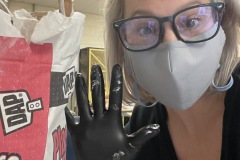Tracy Brown-Fox, Ph.D., Chemistry, Johnson C. Smith University
Understanding the science behind black hair goes beyond the latest and stylish hairstyles that African-American women and men often wear. African-American women have been persuaded to adopt European looks by chemically and physically manipulating their natural fibrous biopolymer protein called keratin – polypeptide chains of amino acids such as glycine, alanine, and cysteine. However, black hair’s social impact in America can sometimes supersede the science, which history shows can be extrapolated back to Africa – long before the horrific Trans-Atlantic Slave trade. African-American hairstyles have been described best as creative, provocative, historical, and unfortunately, costly and burdensome. No other race of people has faced discrimination for their expression of their hair more than African-Americans. This discrimination has led to limited access to economic opportunities, which has forced African-Americans since the sixties, and mainly women, to subdue their natural hairstyle through chemical hair straightening products and/or wearing wigs and weaves. As a result of complying with corporate America, the black hair care industry has become a multi-hundred-billion-dollar business. The most significant generator is the purchases of wigs and weaves by black women.
Wigs and weaves have evolved over the years, and the mimicking look of wigs and weaves most recognize this evolution to that of natural straighten hair. The close parallel between wigs and weaves to natural hair is primarily based on the chemistry of polymers(plastics) used to fabricate these wigs and weaves by utilizing complex methods of spinning synthetic polymers into synthetic hair. Thus, the black hair experience can be used as a bridge to contextualize its influence on impact on science, social, and economic issues.
In this seminar, CTI fellows will use high-tech instrumentation, including a differential scanning calorimetry (DSC) and thermogravimetric analyzer (TGA) able to examine the chemical and physical properties of synthetic wigs and weaves. Using experimental designs, CTI fellows will examine 1st order (e.g., melting and crystallizing) transitions and heat degradation of the polymers that fabricate synthetic wigs and weaves. Furthermore, as CTI fellows study the science behind synthetic hair, they also would connect it to the social and economic impact on all races and cultures, beginning with understanding the black hair experience.
Seminar Participants:















 Home
Home